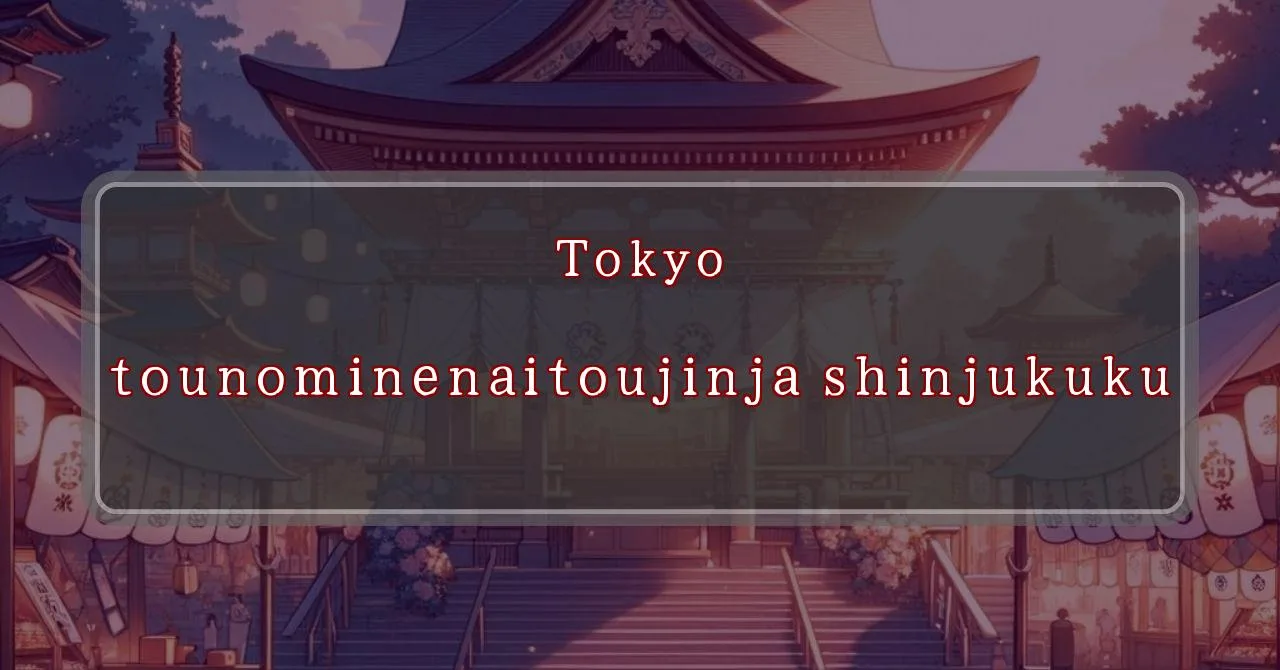Neon dreams: A kaleidoscope of lights at Tonomine-Naito Shrine
Basic Information
Tonomine-Naito Shrine is a Shinto shrine located in Shinjuku-ku, Tokyo, Japan. It is dedicated to the deity Fujiwara Kamatari, the founder of the Fujiwara clan, and other deities.
- Address: 1-8 Naitocho, Shinjuku-ku, Tokyo 160-0021
- Phone Number: 03-3351-7592
- Access: 7-minute walk from Shinjuku-Gyoenmae Station on the Tokyo Metro Marunouchi Line, or 8-minute walk from Sendagaya Station on the JR Chuo-Sobu Line
- Festival Days: May 18th (Sat), May 19th (Sun), 2024 (Reiwa 6)
Main Events and Attractions of the Festival
The Tonomine-Naito Shrine Festival is an annual event that takes place over two days in May. The festival features a variety of traditional Japanese music and dance performances, as well as food and games. One of the most popular attractions of the festival is the mikoshi parade, in which a portable shrine is carried through the streets of Shinjuku-ku.
Mikoshi Parade
The mikoshi parade is the highlight of the Tonomine-Naito Shrine Festival. The mikoshi is a portable shrine that is believed to be the dwelling place of a deity. During the parade, the mikoshi is carried through the streets of Shinjuku-ku by a team of people. The parade is accompanied by traditional Japanese music and dance performances.
Kagura Performance
Kagura is a traditional Japanese dance and music performance that is often performed at Shinto shrines. During the Tonomine-Naito Shrine Festival, kagura performances are held on both days of the festival. The performances are typically performed by young women who are dressed in traditional Japanese clothing.
Food and Games
The Tonomine-Naito Shrine Festival also features a variety of food and games. There are food stalls selling traditional Japanese dishes such as yakitori, takoyaki, and okonomiyaki. There are also games such as ring toss and goldfish scooping.
- Food Stalls:
- Yakitori: Grilled chicken skewers
- Takoyaki: Octopus dumplings
- Okonomiyaki: Japanese savory pancake
- Games:
- Ring Toss
- Goldfish Scooping
Blessings and Deities
The Tonomine-Naito Shrine is dedicated to the deity Fujiwara Kamatari, the founder of the Fujiwara clan, and other deities. Fujiwara Kamatari is revered for his contributions to the Taika Reforms, which were a series of reforms that were implemented in Japan in the 7th century. The reforms aimed to centralize the government and strengthen the power of the emperor. Fujiwara Kamatari is also credited with founding the Fujiwara clan, which was one of the most powerful clans in Japan for centuries.
- Deity: Fujiwara Kamatari
- Blessings: Success in business, academic achievement, good luck in relationships
Origin and History
The Tonomine-Naito Shrine was founded in the early 17th century by Naito Kiyomori, a samurai who was granted a large estate in the area by Tokugawa Ieyasu, the founder of the Tokugawa shogunate. Naito Kiyomori built a shrine on his estate to enshrine Fujiwara Kamatari, his family’s ancestral deity. The shrine was originally known as the Naito Shrine, but it was renamed the Tonomine-Naito Shrine in 1967.
- Founded: Early 17th century
- Founder: Naito Kiyomori
- Original Name: Naito Shrine
- Renamed: 1967
Tips and Notes for Visitors
The Tonomine-Naito Shrine is a popular destination for visitors, especially during the annual festival in May. Here are some tips and notes for visitors:
- Hours: The shrine is open from 9:00 AM to 5:00 PM daily.
- Admission: Admission to the shrine is free.
- Dress Code: Visitors are expected to dress respectfully when visiting the shrine.
- Photography: Photography is allowed inside the shrine, but visitors are asked to be respectful of other visitors and not to take pictures of people without their permission.
- Festival: The annual festival is held on May 18th and 19th. The festival features a variety of traditional Japanese music and dance performances, as well as food and games.
Parking Information
There is no parking lot at the Tonomine-Naito Shrine. Visitors are advised to use public transportation or park in a nearby parking lot and walk to the shrine.
- Parking Lot: None
- Public Transportation: The shrine is a 7-minute walk from Shinjuku-Gyoenmae Station on the Tokyo Metro Marunouchi Line, or an 8-minute walk from Sendagaya Station on the JR Chuo-Sobu Line.
- Nearby Parking Lots: There are several parking lots near the shrine. Visitors can use the Park and Ride facility at Shinjuku-Gyoenmae Station.
Popular Stalls and Food Carts in Recent Years
| Type of Stall | Description |
|---|---|
| Takoyaki | A staple at Japanese festivals. Characterized by a crispy outside and a creamy inside. |
| Jaga Butter | A simple yet popular snack of hot potatoes lavishly topped with melted butter. |
| Baby Castella | Small castella cakes, sweet and fluffy treats enjoyed by children and adults alike. |
| Grilled Ayu with Salt | Fresh ayu fish grilled whole with salt, a savory taste of Japanese summer. |
| Shaapin | A unique gourmet item influenced by foreign cuisine, with a chewy skin wrapping the filling. |
| Okonomiyaki | A Japanese grilled dish where you often choose your own ingredients for a personalized flavor. |
| Cotton Candy | A fluffy, sweet snack that’s extremely popular with children. |
| Chocolate Banana | A banana coated in chocolate, a fun and visually appealing dessert. |
| Kushiyaki | Various types of ingredients skewered and grilled, an easy-to-enjoy snack. |
| Yakisoba | Fried noodles mixed with a special sauce, a fast food favorite in Japan. |



